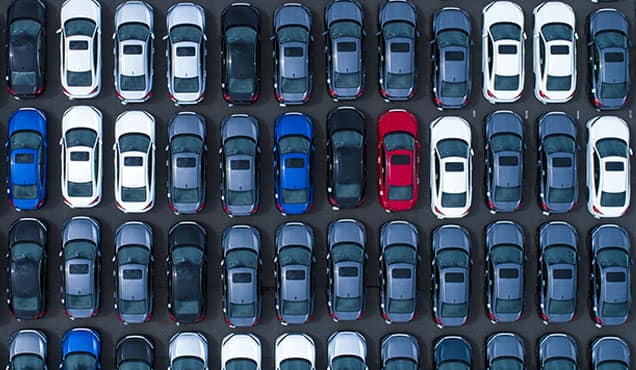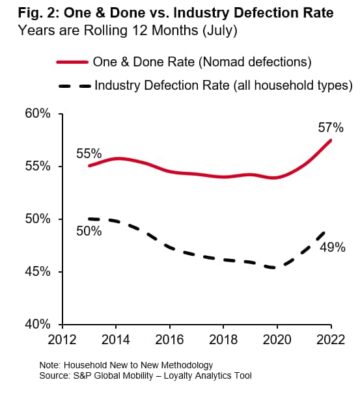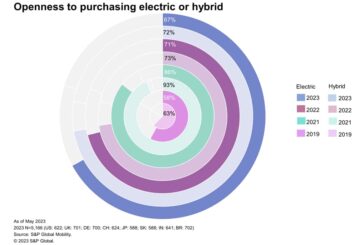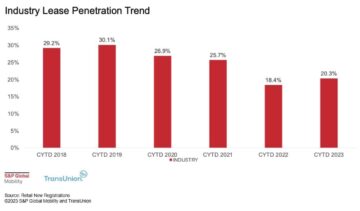
Middle East/Africa sales
December 2022: +8.7%; 0.318 million units vs. 0.292
million units
YTD 2022: +5.6%; 3.756 million units vs. 3.556 million
units
- Light vehicle demand in the Middle East and Africa (MEA) region
posted an estimated increase of 8.7% in December 2022 compared with
the same month in 2021, signaling a stable demand trend during the
final months of the year. The upward trajectory has now been
positive over five consecutive months. However, the uncertainty
regarding global inflationary pressures and rising interest rates
will continue to cast doubts that a fuller recovery in new-vehicle
registrations is possible, as the first half of the 2023 outlook
continues to call for a weak pace regarding modest car demand.
- Regarding new vehicle registrations over the last year, the
first and third quarters each posted low, albeit positive growth
rates, while the second and fourth quarters posted high rates above
8.0%.
- The main external events that heavily affected demand for new
vehicles were the supply crunch due to the global semiconductor
shortage and the Russia-Ukraine conflict. The latter has created
many knock-on effects such as imbalances regarding the global
energy sector, disruptions to key agricultural supply chains, and
the associated cost pressures that have worsened the high inflation
trend that had already begun halfway through 2021 following the
pandemic-related economic turbulence and fiscal stimulus provided
by governments and central banks as economic sectors reopened with
pent-up demand. These events are expected to remain in global
current affairs throughout 2023.
- As for 2022, new-vehicle demand is estimated to have matched
the result of 2021 and surpassed 3.5 million units for the second
consecutive year, rising by 5.6%. This result has taken volumes
back on track toward achieving the level of sales reported in 2019,
just before the outbreak of the global COVID-19 pandemic.
Nevertheless, several years will pass until volumes hit the
5.0-million-unit mark—the level reached back in 2014 (nine
years ago).
- Vehicle supply chain disruptions will continue in 2023 as
specific factories in Germany and neighboring countries are greatly
impacted owing to the raw material shortages and regional
transportation logistics of vehicle parts resulting from the war in
Ukraine. Central European countries such as Poland, Czechia, and
Slovakia also have significant vehicle plants and are more
dependent on suppliers located within Ukraine. Furthermore, China’s
turbulent on-and-off COVID-19 lockdown policies will continue to
impact its vehicle manufacturing sector, and export plans may fall
short of targets. As a result, premium vehicles made in Germany and
exported to the MEA region will continue to be more restricted
owing to lower production levels in the short term. This will also
apply to new Chinese-based OEMs that have targeted MEA with their
vehicle exports. Other car makers continue to adapt and many have
increased their vehicle sourcing from South Asia, namely India, to
meet client expectations and keep the sales order backlog under
control.
- In recent years, regional economies were already very fragile,
and the COVID-19 pandemic further deteriorated both business and
consumer confidence levels. In addition, record-low crude oil
prices in 2020 through mid-2021 further depressed the economies of
countries that heavily depend on oil export revenues, as global
supply heavily overshadowed global demand. Key industry sectors in
developed countries, such as airlines, cruises, cargo shipping,
fuel stations, and manufacturing plants, significantly lowered
their demand for oil, resulting from government-imposed lockdowns
forcing consumers to stay at home. As a result, countries heavily
dependent on either oil or tourism revenues crashed across the
region. At present, a more positive turnaround gathered pace in the
first half of 2022 for crude oil-exporting nations, underlined by
high global prices, while tourism-based countries experienced a
slight uptick in the second half of the year. In sum, the economic
recoveries will gain momentum at various speeds, depending on each
region’s and country’s specific core sectors. Additionally, the
conflict between Russia and Ukraine has resulted in the escalation
of global oil prices, as many countries have decided to halt the
import of Russian oil and gas. As a result, lower supply will lead
to higher prices for consumers and industry. Other crude
oil-exporting countries are set to gain significantly, which should
be the case for Gulf countries. Robust demand for commodities has
benefited specific countries. The return of tourism will also
kickstart the revival of car rental companies, representing an
important market share in some countries that have frozen new
registrations since the start of the pandemic and decreased the
size of their fleets to readjust to demand levels. Higher demand
for new vehicles will face longer waiting times because of the
global chip shortages that have forced carmakers to slow production
rates. As a result, many registrations will be pushed out to early
2023.
- Estimated full-year volumes in January-December 2021 were up by
19.0%, rebounding from the overall negative trend that developed in
the past six years (2015-20), in which vehicle sales steadily
decreased from 4.6 million units to 2.9 million units. The economic
recovery will enable countries across the region to plan for
expansion projects and support dynamic sectors with industries
adapting to future consumer requirements, such as energy resources.
Nevertheless, we continue to highlight the need for structural
economic reforms to be implemented, as specific sectors will
continue to overshadow this recovery.
- The estimated forecast for full-year 2022 for the MEA region is
set at 3.756 million units (revised down by 0.9% versus last
month), representing a 5.6% year-on-year (y/y) increase, which
still holds total regional volumes back to levels reached 16 years
ago—in 2006. Moreover, falling demand in six consecutive years
(2015-20) highlights the economic instability across the region and
consumers’ cautiousness to commit to a new-vehicle purchase.
- Vehicle sales in December 2022 were affected by the distinct
performances across the region, with specific economic developments
affecting various markets and subregions in different ways. Vehicle
demand during December 2022 in the Middle East (excluding Iran) and
the Gulf rose by 22.3% compared with the same month in 2021 but
posted a slight decrease in the African continent by 7.2%. Finally,
owing to continued volatility, vehicle demand in Iran increased by
an estimated 12.9%.
- As previously forecast, the rising vehicle demand trend across
the MEA region will be reported at different paces for each country
and depends on the specific nation’s economic recovery plans and
execution. The stronger demand expected in the next few years will
continue to be periodically disrupted owing to a certain degree of
economic volatility from post-COVID-19 “softer” restrictions to
several industries that will continue to linger. Over the next few
quarters, the steady fall in cases associated with the Omicron
variant may bring new business to the travel industry and wider
economies throughout the region after significant disruptions over
the last few years. The result will be higher sales orders from
rental companies to renew their vehicle rental fleets.
Additionally, the slower recovery pace of vehicle registrations
will fail to match the higher demand from consumers for new
vehicles resulting from the cautious easing of economic
restrictions—and especially due to the chip shortage affecting
vehicle production globally.
- Sales of new vehicles in full year 2022 may match the previous
year, posting low growth at 0.2% across the Middle East (excluding
Iran) and the Gulf subregion owing to higher projections for
Kuwait, Qatar, and the United Arab Emirates. The introduction of
value-added tax (VAT) rates across the Gulf subregion continues to
proceed as Oman introduced a 5% VAT last year (April 2021),
becoming the fourth Gulf country to do so. Only Kuwait and Qatar
are lagging with their implementation process. Expectations have
now changed for Kuwait and Qatar to introduce the VAT in the next
year, as both countries express concerns that high inflation has
derailed the process. The new target date for VAT implementation
has been pushed out by six months to 2024. The Gulf nations of
Bahrain, Saudi Arabia, and the United Arab Emirates have already
introduced a VAT. Recovery was strong during the last quarter of
2022 and vehicle demand is expected to post an equally high
registration pace in the first quarter or 2023. The success of the
World Cup tournament held in Qatar during November and December
have allowed the country and Gulf subregion as a whole to shine
globally, bringing stronger calls for more business ventures to
support further economic expansion projects in several Gulf
countries. More sporting events and tourism will benefit the other
sectors as economic diversification plans continue. Also, the rise
of global energy (oil and natural gas) prices and the sector’s
critical transformation globally will benefit the Gulf subregion’s
economic landscape.
- Demand for new vehicles in the Middle East and Gulf region
(excluding Iran) rose by an estimated 22.3% in December 2022,
slightly improving the recovery that has begun to form in the
region. Across the region, many countries have lifted economic
restrictions, and business activity has returned. For 2023, new
vehicle demand will continue to recover throughout the year. At the
extreme end of the scale, Iranian vehicle sales collapsed in two
years during 2018-19 to levels reached over 20 years ago, crashing
from the highs registered in 2017 at 1.6 million units, down to 0.8
million units in 2019. Since then, Iranian consumers have been
denied American, European, Japanese, and Korean vehicle badges,
resulting in the local industry slowly climbing back up while
struggling to scale vehicle production up until the present day.
Moreover, several Chinese carmakers have rushed to fill the gap
left by their Western competitors and captured significant sales
volumes during this time. As a result, the stark double-digit
declines in the past that were a direct result of the renewed
economic sanctions imposed by the United States have now been
slowly recovering thanks to aid from the Chinese car industry’s
export strategy. The Iranian market in 2022 is now expected to grow
by 23.7%, posting the third consecutive year of higher vehicle
sales. Nevertheless, economic developments will continue to be a
concern and affect the current-day sentiments of Iranians. Looking
forward, Iranian car owners will continue to hold onto their
vehicles for a longer period of time, thus driving up the age of
the fleet of Iranian vehicles. In turn, this trend will lead to
higher demand for new vehicles in the longer term.
- Across the Gulf region, higher taxation may slightly slow
demand for high-priced goods. Iran and Saudi Arabia are the largest
vehicle markets in the Middle East and Gulf region, and their
performance will significantly affect overall demand. In recent
years, Iran’s vehicle demand registered one in every two vehicles
sold in the region, thus highlighting the importance of the
country. Now Saudi Arabia is looking to kick start its own vehicle
manufacturing sector and is providing financial funding to some
electric vehicle startups such as Lucid Motors with the intention
that more OEMs will follow suit.
- Unfortunately, the African continent felt the full force of the
COVID-19 pandemic in the second half of 2020; this struggle
continued throughout 2022, as the global epicenter of the virus
shifted onto the continent. African leaders continue to focus on
containing the virus from further spreading. South Africa, in
particular, recorded a significant number of positive cases, thus
having registered a fourth wave brought on by the Omicron variant
in the first quarter of 2022. At present, registered active cases
are decreasing and the continent has now begun to return to some
normality regarding economic activity.
- Nevertheless, demand for new vehicles in Africa are estimated
to have increased by an estimated 20.7% in full-year 2021, despite
social unrest and signaling the green shoots of recovery, as
substantial pent-up demand has significantly risen over the years.
Since 2015, vehicle sales have considerably fallen from the highs
of fewer than 2.0 million units to the current lows of fewer than
1.0 million units. The positive momentum during late 2018 and the
first half of 2019 was short-lived, and the start of a turnaround
has begun again from mid-2021 onward. Countries in North Africa,
such as Algeria and Morocco, fell into negative territory in 2020,
joining South Africa and hurting the region’s overall demand
levels. As a result of much weaker consumer demand, vehicle demand
across Africa heavily decreased by 27.2% in full-year 2020, despite
some relative support from the rise in commodity prices. Vehicle
demand will also continue to be heavily affected by slightly higher
levels of global crude oil demand, as a trending recovery in prices
has materialized in late 2021. Nevertheless, total African vehicle
demand has fallen back to levels achieved 17 years ago, in 2006.
This scenario will lead to more hardship across Sub-Saharan
countries, while North African countries will also suffer from a
cautious recovery in Western Europe. For 2022, sales of new
vehicles in the African continent are estimated to have slightly
fallen by 3.0% versus the previous year.
- North African countries have also been struggling to put their
economies on the right path to economic growth. Demand for new
vehicles heavily fell in the three-year period of 2015-17 owing to
the economic collapse in Algeria, Egypt, and Tunisia. Overall,
North African vehicle sales have fallen to levels registered 15
years ago. In 2018, Algeria implemented a vehicle import quota
system, and it has since continued to tank, with sales developments
destined to be drastically lower than the normal market demand. In
fact, new-vehicle registrations are estimated to have reached an
all-time low in 2021 at 21,000 units, an abysmal gap from the highs
of 500,000 units in 2012 and 2013 for Algeria. For 2022, the
Algerian car market is forecast to slightly rise, at just above
25,000 units. Egypt’s vehicle market posted strong results in 2021,
up 25%, following a few turbulent years, and should continue on the
path of a smooth recovery throughout the near term. Full-year 2022
demand will likely decrease but continue to surpass 190,000
vehicles for the third consecutive year. Finally, Morocco’s vehicle
market continues to develop in line with its economic growth,
despite weaker sales resulting from effects of the COVID-19 virus
outbreak on the economy and significant trading partners.
New-vehicle demand rose by more than 30% in 2021, and a similar
target of above 160,000 units is set for 2022. The overall recovery
in demand will likely be mild for new vehicles across North Africa
in 2022, as more carmakers and many tier suppliers have delayed
expanding their manufacturing footprint in the region.
- The Sub-Saharan region has also struggled in recent years owing
to low global oil prices hurting oil revenues for exporting
countries and low commodity prices hurting agricultural and mining
revenues for other countries. Following the high volumes reached in
2014, vehicle demand has struggled to achieve any consistency,
trending downward in the past five years, and imports of used
vehicles continue to flood the continent despite the government
policy. Vehicle sales in 2022 are estimated to remain at the levels
achieved 20 years ago. A stronger turnaround is projected beyond
2024 as more governments implement growth strategies for the
automotive sector.
- South Africa is the largest vehicle market in Africa, but the
economic landscape has been extremely difficult during the past few
years and was further depressed owing to COVID-19, despite recent
strong demand for natural resources and precious metals. Demand for
new vehicles continues to be recovering, yet cautious owing to an
outdated automotive policy and the political tension within the
African National Congress (ANC), which in turn has led to a soft
economic policy. The ANC led by Cyril Ramaphosa won the general
elections held in May 2019, and the party’s main task has been to
provide greater stability, which is critical and necessary to turn
around low consumer confidence levels. Big-ticket purchases, such
as new vehicles, have been largely postponed during the COVID-19
pandemic and should recover at a more solid pace well into the
first half of 2023. As a result of the government lockdown
measures, which restricted movement and closed businesses over
several months in 2020, consumer spending sharply declined. At
present, a recovery is slowly unraveling, and vehicle sales in the
full year of 2021 were up by 22.1%. However, the results continue
to lag behind the pre-pandemic sales performance of 2019, which
shows the underlining struggle to renew the vehicle fleet.
Furthermore, social unrest will continue to be an economic threat
as recently staged, following the arrest of former president Jacob
Zuma. The resulting chaos, looting, and violence in the Gauteng and
Kwa-Zulu Natal provinces hurt local communities and businesses. For
2022, new-vehicle sales have posted gains in each month and
achieved a rise of 13.9% at 507,000 units.
Global crude oil outlook
- The oil market in 2023 will be under new and expanded
management. The United States and the European Union are new market
managers and will attempt to set—or at least influence—the
price of more than 5 million barrels per day (MMb/d) of Russian
seaborne oil exports. The price at which Russian oil is sold, in
turn, can influence other prices. The aim is to keep overall oil
prices moderate to low. OPEC+ is the established market manager. It
will continue to adjust supply, but to support high prices. The oil
market has no master, even if more countries aim to manage it.
Indeed, more market management could continue to fuel the high oil
price volatility we have seen in 2022.
- The disruption to Russian crude oil exports is so far less than
feared, but the story is not over yet. The goal of the US-led price
cap is to keep Russian oil flowing to markets outside of Europe.
But beware of unintended consequences as the more complicated EU
import ban and price cap on Russian product exports hits on 5
February 2023.
- Beijing’s COVID-19 policies will be the biggest factor in
determining if world oil demand growth hits our projections of 1.7
MMb/d in 2023 and again in 2024. The sharp reversal of mainland
China’s zero-COVID-19 policy—many restrictions on mobility have
been eliminated—means that cases will rise, but it also
increases the prospects of a return to oil demand growth once the
winter is over.
- Immunity from price spikes? The Joe Biden administration’s
grant of sovereign immunity—and protection against US
lawsuits—to Saudi Arabia’s prime minister and crown prince
removes a thorn in the US-Saudi relationship. Could this provide
the West with immunity from oil price spikes? It is not
inconceivable that the United States could implicitly coordinate
decisions about how the US Strategic Petroleum Reserve is used with
OPEC+ actions.
- Our base-case assumptions point to moderate oil supply
surpluses for 2023 and 2024, but with inventories still low, OPEC+
action will lift prices above USD80/bbl and USD90/bbl. Keep in mind
that geopolitical struggles among great powers will lead to
surprises and unexpected outcomes.
- Mainland China is learning from the West’s reaction to the war
in Ukraine. Mainland China is eager to better insulate itself from
Western financial and economic sanctions—now and in the future.
In the coming years, mainland China aims to settle some of its oil
purchases in yuan as opposed to the US dollar. If this effort is
successful, it could be among the most profound changes to oil
pricing and trade since the spot and futures markets became the
dominant price-setting mechanism in the 1980s.
Middle East/Africa production
December 2022: -34.8%; 110,000 units vs. 169,000
units
YTD 2022: +9.2%; 2,242,000 units vs. 2,053,000
units
- After the United States reimposed sanctions on Iran in 2018,
companies from various industries, including Stellantis and
Renault, discontinued their business in and with Iran. As a result,
production in the country has essentially relied on the activities
of domestic OEMs, such as Iran Khodro and SAIPA. Since the crash of
the market in the first half of 2019, output has been picking up,
as the supply chain is being reconstructed—the country’s
production volumes are growing every year, with another gain of 10%
in 2022 versus 2021. The key launches were the Tara from Iran
Khodro and the Shahin from SAIPA, and both manufacturers have
announced a lineup renewal in the near future.
- In Algeria, following import restrictions and the obligation
for automotive dealers to invest in industrial or semi-industrial
activities since 2017, several assembly operations have spawned in
the country. However, the local content of this regulatory-related
activity was close to zero, and the system collapsed in 2019 after
the change of administration. Since then, officials have partially
lifted import restrictions, and a new industrial assembly regime is
in place. Within this new framework, production plummeted 97% in
2020 to 4,400 units and remained relatively low in 2022 at about
7,000 units. Renault and Stellantis, which have made investments to
raise the level of local content, will likely attempt to continue
car assembly activities in the country. Mercedes-Benz should also
continue car assembly at its knocked-down (KD) plant near Tiaret
with 3,000 vehicles per year. New energy deals concluded in 2022
may attract additional investments in the country. However, total
volume forecast does not exceed 60,000 vehicles per year in the
long-term horizon.
- In South Africa, volumes remained under pressure in 2020-21 as
the COVID-19 pandemic affected domestic and export demand for
vehicles. Production in 2020 was down 30% compared with 2019 and
recovered only 12% in 2021 thanks to the transfer of some
Volkswagen (VW) volume from Spain and new model launches at
Mercedes-Benz and Toyota. In April 2022, the country was hit by
floods, causing temporary closures of damaged production
facilities, such as the Toyota South Africa Motors plant that
returned to preflood production levels only by the end of September
after four months of halted production. Thus, production in the
country in 2022 only reached +7% versus the previous year.
- In Morocco, pre-COVID-19 production volumes were achieved in
2022, an increase of 17% compared with 2021. Renault’s production
remains strong with high demand for CMF-B LS platform-based
vehicles, and the new PSA plant in Kenitra increases its capacity
utilization every year. It was built with a capacity of 200,000
units per year in 2020 to produce the Peugeot 208; later in 2022,
Stellantis announced plans to double its capacity and the OEM’s
presence in the region.
This article was published by S&P Global Mobility and not by S&P Global Ratings, which is a separately managed division of S&P Global.
- SEO Powered Content & PR Distribution. Get Amplified Today.
- Platoblockchain. Web3 Metaverse Intelligence. Knowledge Amplified. Access Here.
- Source: http://www.spglobal.com/mobility/en/research-analysis/middle-east-africa-sales-and-production-commentary-january-2023.html
- 000
- 1
- 110
- 2%
- 20 years
- 2012
- 2014
- 2017
- 2018
- 2019
- 2020
- 2021
- 2022
- 2023
- 2024
- 7
- 9
- a
- About
- above
- Achieve
- achieved
- achieving
- across
- Action
- actions
- active
- activities
- activity
- adapt
- addition
- Additional
- Additionally
- administration
- affect
- affecting
- africa
- African
- After
- against
- Agricultural
- Aid
- aims
- Airlines
- all-time low
- already
- American
- among
- and
- announced
- Another
- Apply
- April
- Arab
- around
- arrest
- article
- asia
- Assembly
- associated
- automotive
- back
- back on track
- badges
- bahrain
- Ban
- Banks
- barrels
- because
- becoming
- before
- behind
- being
- benefit
- Better
- between
- Beware
- Beyond
- biden
- Biden Administration
- Biggest
- bring
- Bringing
- brought
- built
- business
- businesses
- call
- Calls
- cap
- Capacity
- car
- Cargo
- case
- cases
- causing
- cautious
- central
- Central Banks
- certain
- chain
- chains
- change
- Changes
- Chaos
- China
- chinese
- chip
- chip shortage
- client
- Climbing
- Close
- closed
- Collapse
- collapsed
- coming
- commit
- Commodities
- commodity
- commodity prices
- Communities
- Companies
- compared
- competitors
- complicated
- Concern
- Concerns
- concluded
- confidence
- conflict
- Congress
- consecutive
- Consequences
- consumer
- Consumers
- content
- continent
- continue
- continued
- continues
- control
- coordinate
- Core
- Cost
- could
- countries
- country
- COVID-19
- COVID-19 pandemic
- Crash
- Crashed
- Crashing
- created
- critical
- Crown
- crude
- Crude oil
- crunch
- Cup
- Current
- Date
- day
- Deals
- December
- decided
- decisions
- Declines
- decrease
- Degree
- Delayed
- Demand
- dependent
- Depending
- depends
- Despite
- determining
- develop
- developed
- developments
- different
- difficult
- direct
- Disruption
- disruptions
- distinct
- diversification
- Division
- Dollar
- Domestic
- dominant
- double
- down
- downward
- drastically
- driving
- during
- dynamic
- each
- Early
- easing
- East
- Economic
- economic collapse
- Economic growth
- Economic policy
- economic recovery
- economic volatility
- economies
- economy
- effects
- effort
- Egypt
- either
- Elections
- Electric
- electric vehicle
- emirates
- enable
- energy
- equally
- escalation
- especially
- essentially
- established
- estimated
- EU
- Europe
- European
- European Countries
- european union
- Even
- events
- Every
- exceed
- excluding
- execution
- expanded
- expanding
- expansion
- expectations
- expected
- experienced
- export
- exports
- express
- external
- extreme
- extremely
- Face
- factories
- FAIL
- Fall
- Fallen
- Falling
- few
- fill
- final
- Finally
- financial
- First
- Fiscal
- FLEET
- Flowing
- Focus
- follow
- following
- Footprint
- For Consumers
- Force
- Forecast
- form
- Former
- Forward
- Fourth
- Framework
- from
- frozen
- Fuel
- full
- Fuller
- funding
- further
- Furthermore
- future
- Futures
- futures markets
- Gain
- Gains
- gap
- GAS
- General
- geopolitical
- Germany
- Global
- global prices
- Globally
- goal
- goods
- Government
- Governments
- grant
- great
- greater
- greatly
- Green
- Grow
- Growing
- Growth
- Half
- hardship
- having
- heavily
- Held
- High
- High inflation
- higher
- Highlight
- highlighting
- highlights
- Highs
- Hit
- Hits
- hold
- holds
- Home
- horizon
- How
- However
- HTTPS
- Hurt
- immunity
- Impact
- impacted
- implement
- implementation
- implemented
- import
- importance
- important
- imports
- imposed
- improving
- in
- Including
- Increase
- increased
- Increases
- india
- industrial
- industries
- industry
- inflation
- Inflationary
- Inflationary pressures
- influence
- instability
- Intention
- interest
- Interest Rates
- introduce
- introduced
- Introduction
- Invest
- Investments
- Iran
- Iranian
- IT
- itself
- January
- Japanese
- Joe Biden
- joining
- Keep
- Key
- kick
- Korean
- kuwait
- lagging
- landscape
- largely
- largest
- Last
- Last Year
- Late
- launches
- lead
- leaders
- learning
- Led
- Level
- levels
- Lifted
- likely
- Line
- lineup
- local
- located
- lockdown
- lockdowns
- logistics
- long-term
- longer
- looking
- Low
- Lows
- lucid
- made
- Main
- mainland
- mainland china
- Makers
- manage
- managed
- management
- manager
- Managers
- Manufacturers
- manufacturing
- Manufacturing sector
- many
- Market
- Markets
- master
- Match
- matched
- material
- MEA
- measures
- mechanism
- Meet
- Metals
- Middle
- Middle East
- million
- mind
- Mining
- mobility
- model
- Momentum
- Month
- months
- more
- morocco
- most
- Motors
- movement
- namely
- nation
- National
- Nations
- Natural
- Natural Gas
- Near
- necessary
- Need
- negative
- negative territory
- Nevertheless
- New
- New Market
- new target
- next
- normal
- North
- November
- number
- Oil
- Oil and Gas
- oil price
- oman
- ONE
- Operations
- opposed
- order
- orders
- Other
- outbreak
- Outlook
- outside
- overall
- own
- owners
- Pace
- pandemic
- particular
- partners
- parts
- party
- past
- path
- performance
- performances
- period
- Petroleum
- Place
- plan
- plans
- plants
- plato
- Plato Data Intelligence
- PlatoData
- Point
- Poland
- policies
- policy
- political
- positive
- possible
- Post
- post-COVID-19
- posted
- powers
- Precious
- Precious Metals
- Premium
- presence
- present
- president
- pressure
- previous
- previously
- price
- Prices
- pricing
- Prime
- prime minister
- Prince
- process
- produce
- Product
- Production
- projected
- projections
- projects
- prospects
- protection
- provide
- provided
- providing
- provinces
- published
- purchase
- purchases
- pushed
- put
- Qatar
- Quarter
- raise
- Rates
- ratings
- Raw
- reached
- reaction
- recent
- recently
- recorded
- Recover
- recovering
- recovery
- regarding
- regime
- region
- regional
- registered
- Registration
- relationship
- relatively
- remain
- remained
- remains
- Renault
- renewed
- Reported
- representing
- Requirements
- Reserve
- Resources
- restricted
- restrictions
- result
- resulting
- Results
- return
- revenues
- Reversal
- Rise
- Risen
- rising
- robust
- ROSE
- Russia
- russian
- Russian oil
- S&P
- S&P Global
- sales
- same
- Sanctions
- Saudi
- Saudi Arabia
- Scale
- Second
- sector
- Sectors
- semiconductor
- September
- set
- several
- Share
- sharp
- shine
- Shipping
- Short
- shortage
- shortages
- should
- Shows
- significant
- significantly
- similar
- since
- SIX
- Six months
- Size
- slow
- Slowly
- So
- so Far
- Social
- Soft
- sold
- solid
- some
- Sourcing
- South
- South Africa
- sovereign
- Spain
- specific
- speeds
- Spending
- spikes
- Spot
- Spreading
- Stability
- stable
- stark
- start
- Startups
- States
- Stations
- stay
- steady
- Still
- stimulus
- Story
- Strategic
- Strategic Petroleum Reserve
- strategies
- Strategy
- strong
- stronger
- structural
- Struggle
- Struggles
- Struggling
- SUB-SAHARAN
- substantial
- success
- successful
- such
- Suit
- suppliers
- supply
- supply chain
- Supply chains
- support
- surpass
- surpassed
- surprises
- system
- Target
- targeted
- targets
- Task
- tax
- Taxation
- temporary
- The
- The Future
- The West
- their
- Third
- Thorn
- threat
- Through
- throughout
- tier
- time
- times
- to
- Total
- Tourism
- tournament
- toward
- toyota
- track
- trade
- Trading
- trajectory
- transfer
- Transformation
- transportation
- travel
- travel industry
- Trend
- trending
- Tunisia
- turbulence
- turbulent
- TURN
- Ukraine
- Uncertainty
- under
- Unexpected
- union
- United
- United Arab Emirates
- United States
- units
- upward
- us
- US Dollar
- Variant
- various
- VAT
- vehicle
- Vehicles
- Ventures
- Versus
- virus
- Volatility
- volkswagen
- volume
- volumes
- vw
- Waiting
- war
- Wave
- ways
- West
- Western
- Western Europe
- which
- while
- wider
- will
- Winter
- within
- Won
- world
- World Cup
- year
- years
- Yuan
- zephyrnet
- zero
More from IHS Markit
Mainland Chinese medium & heavy commercial-vehicle market to fall in 2021
Source Node: 845368
Time Stamp: Mar 19, 2021
BriefCASE: Battery Boost – New US graphite supply chains dim import needs
Source Node: 2520662
Time Stamp: Mar 19, 2024
Affordability tops charging and range concerns in slowing EV demand
Source Node: 2372959
Time Stamp: Nov 8, 2023
Automotive Insights – Canadian EV Information and Analysis Q3 2022
Source Node: 1784598
Time Stamp: Nov 3, 2022









